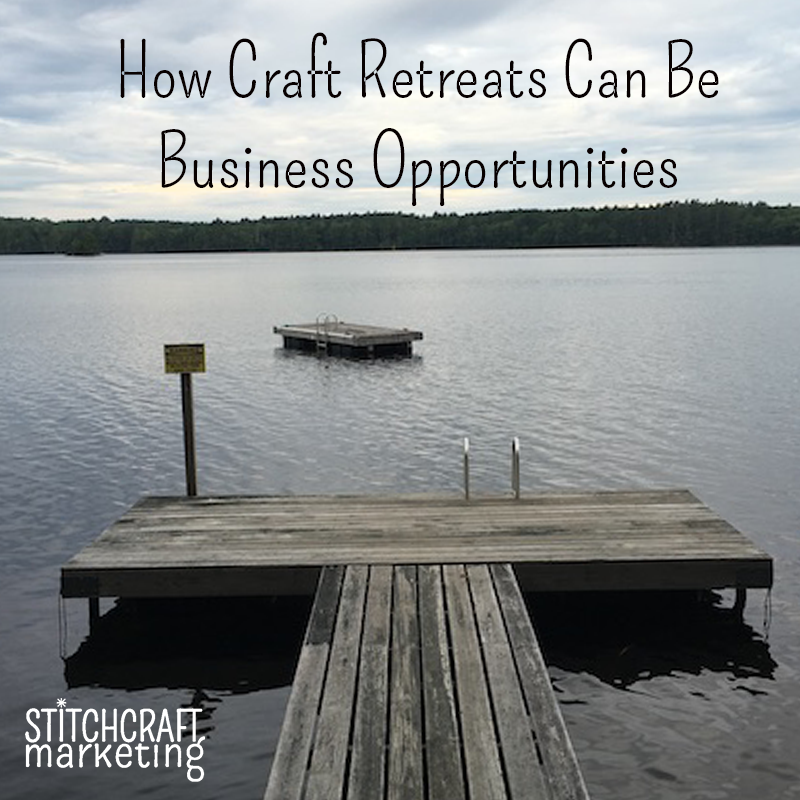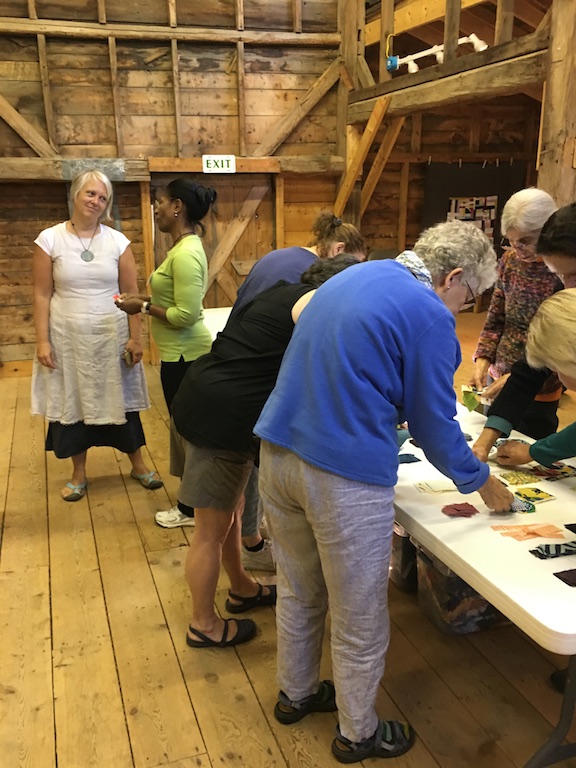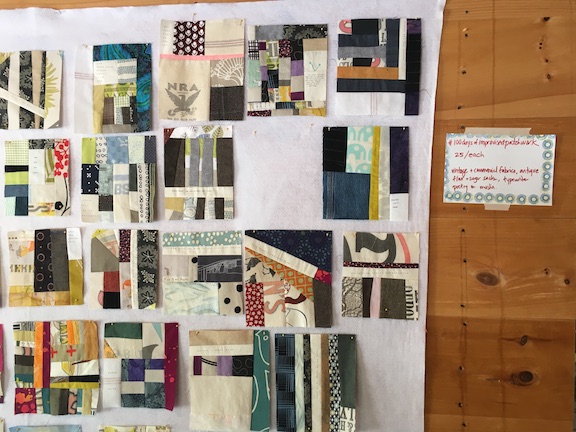
06 Sep Finding the Business Opportunities in Craft Retreats

You’re an artist. You’re a designer. You are an entrepreneur, and you make your living from your craft-based business in every way you can. As a designer and creator (as opposed to a producer of materials), the bulk of your income is derived from your ideas, whether it’s selling patterns or teaching others the techniques they need to know to make your patterns. It can be an itinerant lifestyle, traveling to local shops, conferences and festivals, and guild meetings to fill your teaching schedule with gigs.
Teaching at a Retreat–Pros and Cons
Wouldn’t it be nice to stay in one place for a week and settle in? To give a class to a group of students and give them homework, meeting them again in a couple of days to see how they’ve progressed with the skills and materials, and offering them further information, pointers, and corrections? If that sounds good to you, you might want to explore teaching at a retreat. The beauty of retreats is that they are designed as vacations for the paying participants, so they tend to be in beautiful vacation settings and include recreational amenities (such as access to a waterfront or hiking trails), delicious food, and accommodations ranging from simple to luxurious.
The downside is that you are actually living with your students for the duration of the retreat. You may or may not have your own room to which you can escape, depending on the facilities, but your students will have access to you at communal mealtimes and unscheduled social time. Most of them will respect your downtime boundaries, but you do run the risk of encountering that one student who believes that her tuition entitles her to 24/7 access to your expertise.
In this post, we’ll give an instructor’s eye-view of the benefits of teaching in a retreat setting and how it fits into their lives as craft-industry professionals.Our example is the week-long Medomak Fiber Arts Retreat, an annual retreat held at the Medomak Retreat Center in Washington, Maine.You may want to look into similar opportunities to reach small but new audiences for your segment of the craft world.
A Sample Schedule
In 2017, the Medomak Fiber Arts retreat offered classes by six instructors, five of whom are based in the Portland, ME, area, and one who came from Seattle, WA. Their fiber and textile areas of expertise covered a broad range of crafts, and they tried new crafts during the course of the week, learning from each other in their downtime from teaching. Each instructor was paid $1200 for the week, plus room and board in a shared cabin and offered 10-12 hours of instruction. Alissa Allen is a specialist in mycopigments, natural dyes from mushrooms. She taught classes in foraging for dye mushrooms, applied mordanting, testing for color, and dyeing marbled skeins of yarn with mushroom dyes. Dana Fadel, a weaver, taught 4-harness twill techniques. Katherine Ferrier, a dancer and patchwork artist, taught both early-morning movement classes and a two-part class in improvisational patchwork, including both piecing and quilting. Bristol Ivy, a knitting designer, taught knitting classes on intarsia, knitting with refinement, shawl shapes, and short rows. Rachel Bingham Kessler, a dyer and spinner, lead students around the campus in Foraged Color: Exploring Medomak’s Landscape Through Plants. She also taught nuno felting, and a shibori technique class in which students stitched resist patterns into garments which could then be dyed in her Playing in Blue: Exploring Multiple Indigo Vats and Recipes class. Casey Ryder, the owner of Portfiber in Portland, ME, and the coordinator of the retreat, taught a two-part rigid heddle weaving class, a coil baskets class, and a class on needle-felted mushrooms. All of the weaving classes and the improvisational patchwork class required students to work on projects between class meetings. The two-part dyeing classes could be taken separately, but the shibori stitching needed to be completed before the indigo class on the last day.
Retreat Teaching as a Revenue Stream
We spoke with Katherine Ferrier at length to get an idea of how teaching at a retreat is an integral part of both her artistic practice and her craft business. Katherine self-identifies as an improviser in all her creative endeavors: dance, quilting, and writing. At the Medomak Fiber Arts Retreat, she taught Following the Thread–Explorations in Improvisational Patchwork, as well as an early morning class, Mindful Movement for Makers.
Ferrier’s approach to patchwork focuses on relationship: “Patchwork is noticing the relationship between two things…how they sing together,” she notes. The booklet she prepared as a class handout was a mix of practical technique, diagrams, poetry, reflections, and resources/inspirations, inviting students to “pay attention and play attention” to piece fabric together not with a plan, but by letting the thing being made show them what it wants to be. The booklet opens with an original poem:
to make
(to take two things
and put them together)
to love a seam
for what it means:
that all the pieces
find a home.
Students worked on hand-stitching their patchwork pieces, learning how to use rotary cutters, to backstitch to hold things together, and to accept that some of what they loved about a particular piece would be lost to the seam allowance. After the three-hour session on patching, the barn was filled for the next two days with students cutting, piecing, pressing, and sewing in order to have their patchwork finished for the second session on quilting. Within the time constraints of the retreat, most student pieces were about 8.5’ x 11”, although some enthusiastic students, and others with prior quilting experience, put together larger pieces or more than one. Ferrier charged students a materials fee of $10, which included her booklet, a handmade needlebook embellished with patchwork; four needles, including a quilting needle and a self-threading needle, pins, and access to bins of scraps and bolts of fabrics for piecing and backing, a choice of battings, and a package of sashiko embroidery thread to be used in the quilting stage of the project.


Retreat teaching tends to be seasonal, at least in North America. Ferrier finds that her summer schedule fills with teaching gigs, turning fall and winter into the time when she is doing most of her own creative production.The Medomak retreat was one of four intensive retreats at which Ferrier taught and/or facilitated in July and August 2017. Her previous position as the studio manager for Samantha Hoyt Lindgren’s A Gathering of Stitches in Portland, Maine, was her point of contact for two different Slow Stitching retreats. Slow Fashion 2017 was held at Ferry Beach in Maine in July, with Cal Patch, Katrina Rodabaugh, and Jessica Lewis Stevens; Ferrier remained at Medomak Retreat Center for another week to manage Slow Stitching 2017 with Chawne Kimber, Heather Jones, and Kim Eichler-Messmer. In later August, Ferrier taught an improvisational dance workshop at the Abrons Arts Center, a program of the Henry Street Settlement on the lower East Side of New York.
“I have been working for years to see how these different worlds of mine work together,” Ferrier noted. It’s a balancing act; teaching is an income stream for part of the year, but it takes away from her own making time. Ferrier continues to hold a part-time job in Bethlehem, New Hampshire, curating the Women’s Rural Entrepreneurial Network (WREN) Gallery and working with artists to help them with the business side of creating: plans, pricing, presentation, and applying to shows. She laughed, noting that it is a “Physician, Heal Thyself” situation. Between the commissions, the garments, and the teaching, she has literally patchworked her living together. Making art and teaching others how to embrace the creative process has become the basis of her living as well as her life. Ideally, Ferrier would like to spend about half her time on the road teaching, and the other half working on her commissioned quilts, garments, and other art pieces.
Does It Fit Your Lifestyle?
Teaching at retreats means living out of your suitcase and/or your car. Allen, who came to Maine from the west coast, knew down to the pound exactly how much her mushrooms, fiber, and other equipment weighed and chose her airline based on the free checked baggage allowance. (An east coast fungi friend gives her space to store her propane burners and dye kettles.) Making a living income from itinerant teaching opportunities is predicated on a flexible lifestyle. It’s hard. As someone who is responsible only to herself, Ferrier can take advantage of the opportunity to book her summer almost back-to-back with teaching, whereas Bingham Kessler schedules the rest of her year to make sure she can be away from her other responsibilities to so she can continue to teach at the Medomak retreat. It’s a non-negotiable part of her personal calendar.
The instructors found that teaching at this retreat (and others) allows them to experiment with ideas and materials in ways that can become a foundation for another income stream. Ferrier installed a display of her recent work in the barn: 100 Days of Patchwork featured small unquilted assemblages incorporating her typed on fabric word work. They were available for sale, as were her improvisational patchwork garments. Ivy’s forthcoming book from Pompom Press grew out of her teaching about rates of increasing and decreasing to create knitted shapes. In an evening presentation, Ryder (who is the US sales rep for Tajik Cashgora yarn which are made by a woman’s cooperative in Tajikistan) gave retreat participants the opportunity to follow her journey to Tajikistan and meet the women who produce the yarn she reps and sells. It was available onsite at the retreat as a suitable yarn for the rigid heddle weaving class she taught, as well as for any other projects this group of avid fiber artists could imagine. Bingham Kessler not only taught students how to dye with native plants, but offered her own handspun, plant-dyed yarns and handmade project bags for sale as well. Anyone who wanted to experiment with mushroom dyes after Allen’s workshops could purchase a quart mason jar from her filled with materials and instructions needed to dye a scarf or a single skein of yarn.
In an intimate setting such as a retreat, students and instructors become friends as well. Connecting on social media – whether it’s personal, or joining a Facebook group devoted to mushroom dyeing, or following an instructor on Instagram or Pinterest – allows the students to reconnect with camp’s creative energy throughout the year, wherever they are. From the instructor’s perspective, it builds a following among people whose likes and shares will have a ripple effect. People who think fiber and textile camp (or any craft-centered retreat) is a great idea for a vacation are the audience a craft professional wants, and connecting with them links you with the rest of their friends who share that interest, whether they attended the retreat or not.
Connecting with a Retreat
Opportunities to teach at a retreat generally come through word-of-mouth. Your contacts within your particular craft niche may have had a gig that no longer fits their lifestyle or schedule and they can recommend you. Contacts in other crafts may know of retreats that need your particular skill set to complement their other offerings. Or perhaps you could collaborate with a bunch of your fellow craft instructors and put together your own retreat at an inviting location. Learning vacations are very much on-trend, and they appeal to a population with plenty of disposable income to spend on your products and those from other local producers. The Medomak Fiber Arts Retreat always includes field trips to local producers, whether it’s a farm studio, a dyer’s workshop or a local textile factory like Swans Island Company. If your business fits one of these categories, you may want to make a connection with a local retreat to become a field trip destination to show off your work and your creative process while providing a souvenir shopping opportunity.
Retreats are a valuable part of the craft industry. Finding a place to connect to the possibilities is another way to grow your business.
For tips like these and other services, contact leanne@stitchcraftmarketing.com to learn how we can help you take your craft business to the next level.


No Comments